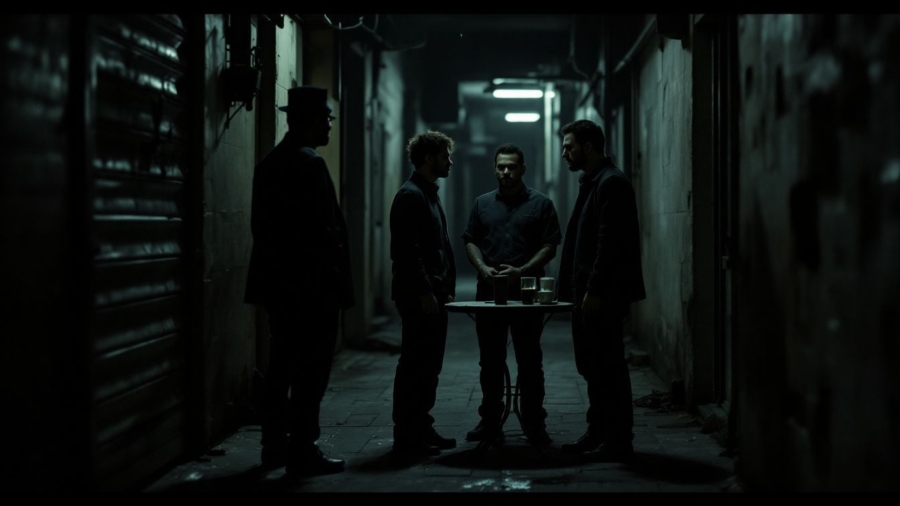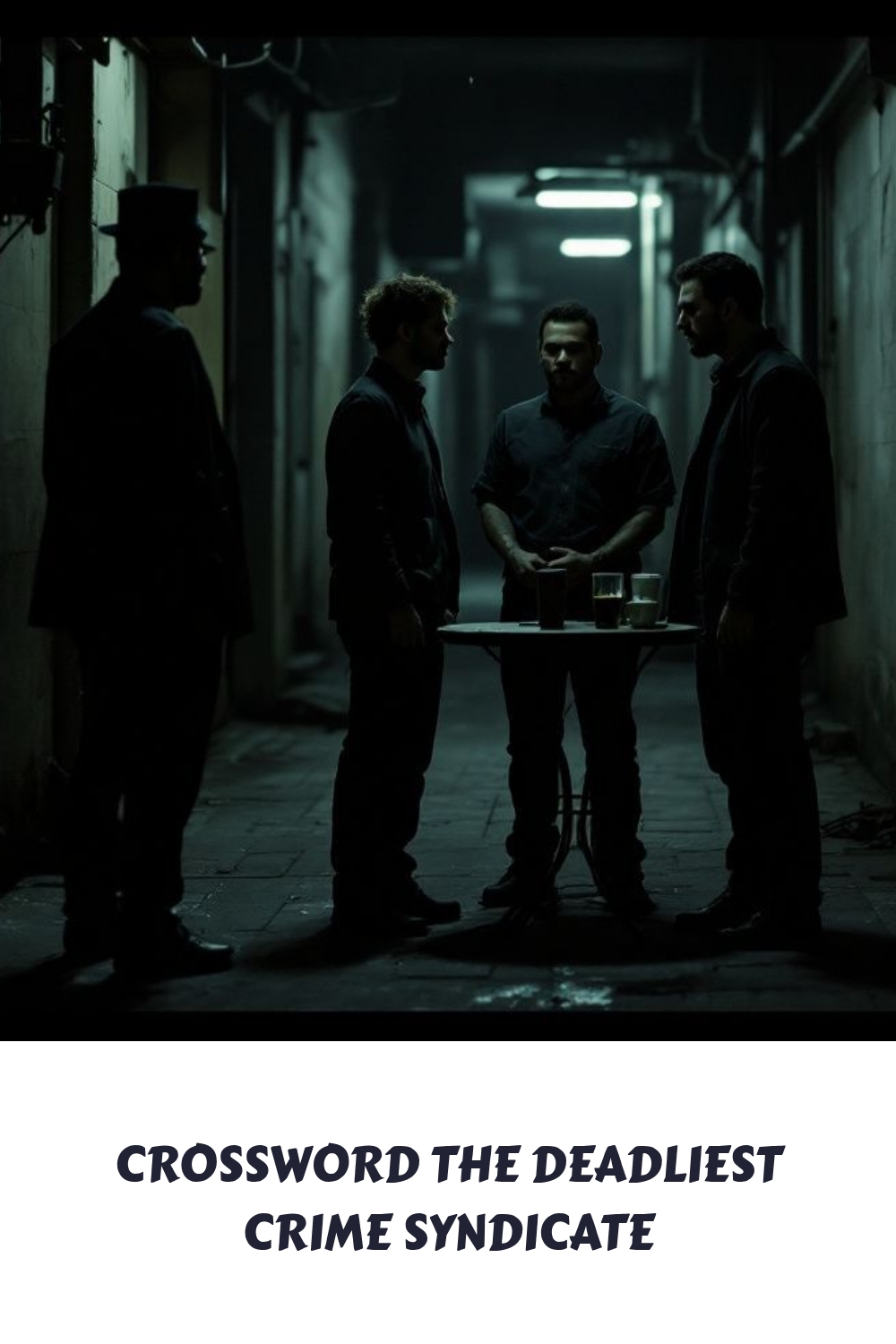How was Murder Inc. structured and what were its methods of operation?
Murder Inc. operated as the Deadliest Crime Syndicate, with remarkable efficiency, mirroring a legitimate business in its structure and compartmentalization. Its headquarters was an unassuming 24-hour candy store in Brownsville, Brooklyn, called Midnight Rose, run by a sweet elderly woman, Rosie Gold. Hitmen would gather there, waiting for assignments.
The chain of command was designed to insulate the top mob bosses from the actual killings. “The Commission” would sanction a hit, passing the order to Anastasia and Lepke. They, in turn, would assign the job to one or more of their contract killers. Crucially, the hired killers often had no personal connection to the victim or the motive behind the hit, making it harder for law enforcement to trace orders back to the leadership of the Deadliest Crime Syndicate.
Their methods were brutal and varied:
- Weapons: Ice picks (often thrust into the ear or skull to mimic a natural hemorrhage), .38 revolvers, knives, ropes for strangulation, meat cleavers, and even bare hands or fire were commonly used.
- Planning: Hits involved meticulous planning, including stealing getaway cars, securing fake license plates, having “finger-men” identify targets, and planning escape routes. Weapons and cars used were often destroyed afterward.
- Disguises & Diversions: Hitmen sometimes used disguises (like Happy Maione dressed as a woman for a hit) or staged accidents to throw off police.
- Body Disposal: Bodies were frequently left in public places as warnings, sometimes with symbolic messages (e.g., rats in a snitch’s mouth). Alternatively, bodies were made to vanish to prevent murder convictions (which often required a body back then) or to deny victims a funeral or life insurance payouts for years.
- Payments: Hitmen received a regular retainer salary (around $125/week in the 1930s) plus $1,000-$5,000 per hit, with benefits for their families if they were caught.
Who were some of the most prominent members of Murder Inc. and what were their specialties?
The Deadliest Crime Syndicate, Murder Inc. boasted a roster of highly violent and feared individuals. On the Jewish side, led by Lepke, key figures included:
- Abe “Kid Twist” Reles: Infamous for his extreme violence and use of an ice pick, often making victims’ deaths appear as brain hemorrhages. He was also known for torture sessions. Reles later became a pivotal informant.
- Harry “Pittsburgh Phil” Strauss: A prolific killer, believed to have committed over 100 murders. He enjoyed creative killing methods, including drowning, choking, and even burning bodies.
- Martin “Bugsy” Goldstein: A Brownsville Boy who partnered with Reles on many hits.
- Mendy Weiss: Lepke’s top guy, influential in drug and garment rackets, and a key participant in high-profile hits like Dutch Schultz’s.
On the Italian side of the Deadliest Crime Syndicate, overseen by Anastasia, notable members included:
- Albert Anastasia (“Lord High Executioner,” “The Mad Hatter”): Though a leader, he was also an active, brutal killer who enjoyed his work.
- Harry “Happy” Maione: Nicknamed ironically, he was a miserable individual who volunteered for every job out of a love for killing.
- Frank “Dasher” Abbandando: Known for his preference for melee weapons and for once beating a mobster with a baseball bat.
- Louis Capone (no relation to Al Capone): Less of a hitman and more of a “HR manager,” he mediated between factions and allocated jobs.
- Charles “The Bug” Workman: Known for rifling through victims’ pockets for extra cash, sometimes making hits look like botched muggings.
What role did Albert Anastasia play, and why was he so feared?
Albert Anastasia was a foundational and central figure in Murder Inc reign as the Deadliest Crime Syndicate. From his arrival in the U.S. in 1919 as a 17-year-old upstart, he quickly established a reputation for extreme ruthlessness and violence, taking over New York’s waterfront and dockworkers unions with his signature weapon, an ice pick. His brutality caught the attention of Lucky Luciano, who saw his potential and helped him escape a death sentence by making witnesses disappear.
When Murder Inc. was formed as the Deadliest Crime Syndicate, Anastasia became Louis “Lepke” Buchalter’s chief deputy and headed the Italian contract killer segment. He earned the nicknames “Lord High Executioner” and “The Mad Hatter” due to his enjoyment of killing and his fierce reputation. Unlike Lepke, who maintained a lower profile, Anastasia relished being known as a vicious murderer.
He was instrumental in organizing the hit squads and implementing the Commission’s orders, ensuring the mob’s grip on the underworld through fear. After Lepke’s downfall, Anastasia took over the entirety of Murder Inc. He was a force of nature whose ambition and savagery eventually led him to take over the Mangano crime family (later the Gambino family) and become a powerful, but ultimately self-destructive, boss.
What was the “Dutch Schultz” hit, and why was it significant?
The murder of mob boss Dutch Schultz in October 1935 was one of Murder Inc.’s most famous and consequential hits. Schultz had become a major problem for the Syndicate due to crusading prosecutor Thomas Dewey, who was relentlessly pursuing him for tax evasion. Schultz, desperate to eliminate Dewey, sought the Commission’s permission for a hit. However, the mob had a strict policy against targeting law enforcement officials, fearing it would bring catastrophic federal attention and a widespread crackdown on all mob operations.
When Schultz defiantly announced he would kill Dewey regardless, the Commission, prioritizing the larger interests of the Syndicate, ordered his assassination. Lepke was tasked with the job and assigned Mendy Weiss and Charlie Workman to carry it out. They tracked Schultz to a restaurant in Newark, New Jersey, where he was gunned down along with his accountant and two bodyguards. The hit was significant because it demonstrated the Commission’s power over individual mobsters, even prominent ones like Schultz, and their commitment to maintaining a united front to avoid unwanted law enforcement scrutiny.
Proving once again that Murder Inc. was the Deadliest Crime Syndicate of all. Ironically, killing Schultz did not deter Dewey, who instead doubled down on his efforts, eventually leading to the downfall of Luciano and Lepke.
How did law enforcement eventually dismantle Murder Inc.?
Murder Inc.’s downfall as the Deadliest Crime Syndicate, began in the late 1930s as federal authorities intensified their crackdown on organized crime. District Attorneys Thomas Dewey and later William O’Dwyer led a persistent crusade against the mob. The key to unraveling Murder Inc. was the turning of key insiders into informants.
The pivotal breakthrough came with Abe “Kid Twist” Reles. Implicated in a murder and facing the electric chair, Reles, despite his own history of brutalizing snitches, chose self-preservation and became a government witness in 1940. He “sang like a canary,” providing incredibly detailed testimony about Murder Inc.’s operations, members, and dozens of murders, blowing the case wide open. Other low-level mobsters, facing similar threats of capital punishment, corroborated Reles’s story, including Albert Tannenbaum and Seymour Magoon.
These informants’ testimonies allowed prosecutors to secure convictions against many of Murder Inc.’s most notorious members, including Frank Abbandando, Harry Maione, Harry Strauss, Martin Goldstein, Louis Capone, and Mendy Weiss. Louis “Lepke” Buchalter, the head of Murder Inc., was also convicted based on Reles’s testimony and became the only major Syndicate leader to be executed in the electric chair. While Reles himself met a suspicious end, “falling” from a hotel window while under police protection before he could testify against Albert Anastasia, his earlier testimony had already caused irreparable damage to the organization.
What was the ultimate fate of its leaders and key members?
The reign of Murder Inc. as the Deadliest Crime Syndicate ended with a series of trials and executions that saw many of its prominent figures meet brutal ends:
- Louis “Lepke” Buchalter: Convicted largely on Abe Reles’s testimony, he was executed in the electric chair in March 1944, making him the only Syndicate leader to face capital punishment.
- Albert Anastasia: He avoided prosecution for Murder Inc. crimes due to Reles’s suspicious death. He continued his career, eventually becoming the head of the Mangano (later Gambino) crime family. However, his extreme brutality alienated other mob bosses, and he was famously assassinated in a barber shop in October 1957.
- Harry “Happy” Maione and Frank “Dasher” Abbandando: Convicted for the murder of Whitey Rudnick, they were executed in February 1942.
- Harry “Pittsburgh Phil” Strauss and Martin “Bugsy” Goldstein: Convicted for the murder of Irving “Puggy” Feinstein, they were executed in June 1941. Strauss famously attempted an insanity plea by growing a beard, mumbling, and chewing a briefcase, but it failed.
- Louis Capone and Mendy Weiss: Executed alongside Lepke in March 1944 for the murder of Joseph Rosen.
- Charles “The Bug” Workman: Pleaded guilty for the murder of Dutch Schultz and received a life sentence, eventually being paroled after 23 years.
- Abe “Kid Twist” Reles: After becoming a key government witness, he died on November 12, 1941, falling from a sixth-story window of the Half Moon Hotel while under police protection. Officially ruled an accident, it is widely believed he was either pushed or facilitated by corrupt police.
In essence, most of Murder Inc.’s key figures either went to the electric chair, were assassinated, or died in prison, reinforcing the mob adage that “the streets always collect.”
As The Deadliest Crime Syndicate. What is Murder Inc.’s legacy and cultural impact?
Murder Inc.’s brutal efficiency and unique role in organized crime cemented its place in American criminal history and popular culture. Despite their heinous acts, their story continues to fascinate audiences.
- Impact on the Mob: While founded to maintain order and reduce gang wars by centralizing “whackings,” their eventual downfall demonstrated the vulnerability of even the most efficient criminal enterprises to internal betrayal and determined law enforcement. Their collapse led to a restructuring within the mob, although the concept of an enforcement arm remained.
- Pop Culture: Murder Inc. has inspired numerous films, literature, and TV shows. Notable examples include the 1951 gangster movie “The Enforcer” starring Humphrey Bogart, and references in “The Simpsons” and “The West Wing.” Their methods, especially the ice pick, and their legendary status as “the mob’s hit squad” have become ingrained in the collective imagination of organized crime lore.
- Historical Significance: They marked a turning point in the U.S. battle against organized crime, as it was one of the first times such senior crime figures were brought to justice and executed. Their story remains a chilling reminder of the dark and dangerous world of the criminal underworld.


 Cart is empty
Cart is empty 

